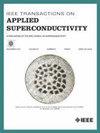Heat Treatment of Large Nb3Sn Coil for CRAFT TF
IF 1.8
3区 物理与天体物理
Q3 ENGINEERING, ELECTRICAL & ELECTRONIC
引用次数: 0
Abstract
The fabrication of a prototype toroidal field (TF) coil for the Comprehensive Research Facility for Fusion Technology (CRAFT) represents a critical component of the China Fusion Engineering Test Reactor project. The CRAFT TF coil, characterized by its distinctive “D” shape, measures approximately 19.5 m in length, 11.5 m in width, and 1.1 m in height. The coil incorporates Nb3Sn cable-in-conduit conductors in both its high-field and medium-field windings. Owing to the intense sensitivity of Nb3Sn superconductors to stress and strain, the manufacturing process will adhere to the established “wind and react” methodology. Among the various manufacturing stages, heat treatment emerges as a pivotal step in the production of TF Nb3Sn coil. We have engineered China's largest superconducting coil heat treatment facility, incorporating a fully argon-purged oven environment. This investigation primarily addresses the computational modeling and experimental validation of thermal gradients and fluid dynamics within the system. The design specifications, structural configuration, and processing parameters of the CRAFT TF heat treatment system have been experimentally validated. System performance evaluation demonstrates compliance with technical specifications, particularly in maintaining temperature uniformity within ±5 °C during the critical 650 °C stabilization phase.工艺TF用大Nb3Sn线圈的热处理
聚变技术综合研究设施(CRAFT)的环形场(TF)线圈原型的制造是中国聚变工程试验堆项目的关键组成部分。CRAFT TF线圈的特点是其独特的“D”形,长度约为19.5米,宽度为11.5米,高度为1.1米。该线圈在其高场和中场绕组中都采用了Nb3Sn电缆导管导体。由于Nb3Sn超导体对应力和应变的高度敏感性,制造过程将坚持既定的“风与反应”方法。在各种制造阶段中,热处理是TF Nb3Sn线圈生产的关键步骤。我们设计了中国最大的超导线圈热处理设备,包括一个完全氩净化的烤箱环境。本研究主要解决了系统内热梯度和流体动力学的计算建模和实验验证。通过实验验证了CRAFT TF热处理系统的设计规范、结构配置和工艺参数。系统性能评估表明符合技术规范,特别是在关键的650°C稳定阶段保持±5°C的温度均匀性。
本文章由计算机程序翻译,如有差异,请以英文原文为准。
求助全文
约1分钟内获得全文
求助全文
来源期刊

IEEE Transactions on Applied Superconductivity
工程技术-工程:电子与电气
CiteScore
3.50
自引率
33.30%
发文量
650
审稿时长
2.3 months
期刊介绍:
IEEE Transactions on Applied Superconductivity (TAS) contains articles on the applications of superconductivity and other relevant technology. Electronic applications include analog and digital circuits employing thin films and active devices such as Josephson junctions. Large scale applications include magnets for power applications such as motors and generators, for magnetic resonance, for accelerators, and cable applications such as power transmission.
 求助内容:
求助内容: 应助结果提醒方式:
应助结果提醒方式:


